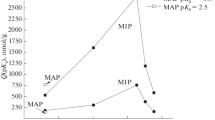Abstract
The process of the silica glass doping with fluorine during its long-term high-temperature treatment at 2100–2300 °C in an oxygen atmosphere containing from 1 to 5 mol% SiF4 has been studied. With an increase in its concentration in the gas, the rate of gas-phase glass etching increases. Fluorine concentration in glass was estimated by refractometry and X-ray microanalyzer. It has been established that under conditions of chemical equilibrium of the silica glass surface with SiF4, an increase in temperature leads to a decrease in the fluorine content in the glass. The process of dissolving fluorine in glass is exothermic. The dependence of its doping degree on SiF4 pressure up to 5000 Pa is close to linear. Under equilibrium conditions, the fluorine content in silica glass is 2 times higher than under the conditions of a nonequilibrium MCVD process.
Graphical abstract










Similar content being viewed by others
References
Tamura Y, Sakuma H, Morita K, Suzuki M, Yamamoto Y, Shimada K, Honma Y, Ka Sohma T, Hasegawa FT (2018) The first 0.14-dB/km loss optical fiber and its impact on submarine transmission. J Lightw Technol 36:44–49
Eronyan MA, Devetyarov DR, Reytskii AA, Meshkovskiy IK, Untilov AA, Pechenkin AA (2021) Radiation-resistant optical fiber with an oxygen-deficient silica. Glass Core Mater Lett 292:129628. https://doi.org/10.1016/j.matlet.2021.129628
Abe K (1976) Fluorine doped silica for optical waveguides. In: 2ndEuropean conference on optical communication. Paris, pp 59–61
Paul MC, Sen R, Bandyopadhyay T (1997) Fluorine incorporation in silica glass by MCVD-process—a critical study. J Mater Sci 32:3511–3516. https://doi.org/10.1023/A:1018697422691
5.Marshall A, Irven J, Boag N, Brooke BN (1984) Mechanism of fluorine dopant incorporation in optical fibers. In: Conference proceeding of 10th ECOC. Stuttgart, Germany, pp 76–77
Kirchhof J, Unger S (2008) Thermodynamics of fluorine incorporation into silica glass. J Non Cryst Solids 354:540–545. https://doi.org/10.1016/j.jnoncrysol.2007.08.084
Kirchhof J, Unger S, Knappe B, Kleinert P, Funke A (1987) About the fluorine chemistry in MCVD: the Mechanism of fluorine incorporation in SiO2 layer. Cryst Res Technol 22:495–501. https://doi.org/10.1002/crat.2170220409
YokotaH, Kanamori H, Tanaka G, Yano K (1985) Performance of pure silica core matched cladding single mode fibers. In: Technical digest IOOC-ECOC’85. Venezia, Italy, pp 77–80.
Guryanov AN, Salganskii MYu, Khopin VF, Kosolapov AF, Semenov SL (2009) High-aperture optical waveguides based on fluorine-doped silica glass. Inorganic Mater 45:823–826. https://doi.org/10.1134/S0020168509070218
Andreev AG, Dukelskii KV, Ermakov VS, Eronyan MA, Kryukov II, Petrovskii GT, Serkov MM, Tsibinogina MK (2006) Investigations of silica glass doping with fluorine using the method of modified chemical vapor-phase deposition. Glass Phys Chem 32:49–55. https://doi.org/10.1134/S1087659606010032
Walker KL, Csencits R, Wood D (1983) Chemistry of fluorine incorporation in the fabrication of optical fibers. In: Digest of technical papers (S. 2) 6th topical meeting optical fiber communication, pp 36–37. https://doi.org/10.1364/OFC.1983.TuA7
Andreev AG, Kryukov II, Mazunina TV, Bureev VS, Eronyan MA, Serkov MM (2013) Doping of silica glass with fluorine by the modified chemical vapor deposition method. Glass Phys Chem 39:285–286. https://doi.org/10.1134/S1087659613030024
Kuppers D, Koenings J, Wilson H (1978) Deposition of fluorine-doped silica layes from a SiCl4/SiF4/O2 gas mixture by the plasma-CVD method. J Electrochem Soc 125:1298–1302. https://doi.org/10.1149/1.2131666
Tandon P (2005) Doping of silica duping sintering. J Non Cryst Solids 351:1466–1472. https://doi.org/10.1016/j.jnoncrysol.2005.03.019
Eronyan MA (2013) The investigation of physicochemical processes of silica glass doping with fluorine by the MCVD method. Glass Phys Chem 39:279–284. https://doi.org/10.1134/S1087659613030073
Kyoto M, Ito M, Ishiguro Y, Kanamori H, Ohoga Y, Ishikawa S (1996) Study of fluorine doping during vapour-phase axial deposition sintering process. J Mater Sci 31:2481–2486. https://doi.org/10.1007/BF01152965
JANAF (1985) Thermochemical tables, 3rd ed. J Phys Chem Ref Data 14(Suppl. 1)
Hermann W, Raith A, Rau H (1987) Diffusion of fluorine in silica ber bunsenges. Phys Chem 91:56–58. https://doi.org/10.1002/bbpc.19870910112
Kirchhof J, Unger S, Klein K-F, Knappe B (1995) Diffusion behavior of fluorine in silica glass. J Non Cryst Solids 181:266–273. https://doi.org/10.1016/S0022-3093(94)00525-7
Acknowledgements
The authors are thankful to Academician of the Russian Academy of Sciences, Professor V. G. Peshekhonov for supporting this work, A. A. Untilov for the scientific and technical helps and Tamkovich M. V. for electron microscope studies.
Funding
This research did not receive any specific grant from funding agencies in the public, commercial, or not-for-profit sectors.
Author information
Authors and Affiliations
Contributions
M.A.E. was involved in conceptualization and writing original. A.Yu.K. contributed to methodology and investigation. M.K.T. was involved in formal analysis, calculations and writing draft. All the authors participated in discussion of the results and manuscript preparation.
Corresponding author
Ethics declarations
Conflict of interest
The authors declare that they have no conflict of interest.
Additional information
Handling Editor: Andrea de Camargo.
Publisher's Note
Springer Nature remains neutral with regard to jurisdictional claims in published maps and institutional affiliations.
Rights and permissions
About this article
Cite this article
Eronyan, M.A., Kulesh, A.Y. & Tsibinogina, M.K. Doping silica glass with fluorine in equilibrium conditions at a temperature of more than 2000 °C. J Mater Sci 57, 11582–11589 (2022). https://doi.org/10.1007/s10853-022-07366-7
Received:
Accepted:
Published:
Issue Date:
DOI: https://doi.org/10.1007/s10853-022-07366-7



